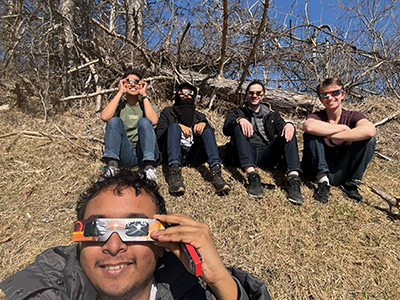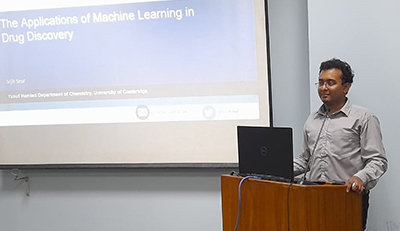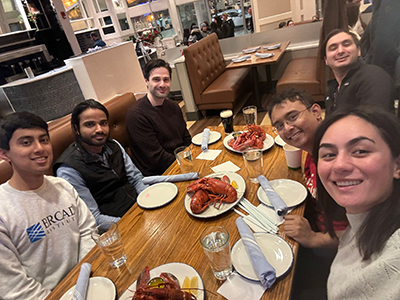
Cell painting images courtesy of the JUMP Consortium and Carpenter-Singh Lab, Broad Institute of MIT and Harvard.
July 15, 2024
Follow the academic journey of Srijit Seal as he opens doors and expands his research horizon. Since 2022, when he won the SLAS Europe Student Poster Competition, the doctoral student has moved from Cambridge University (UK) to the Broad Institute (Cambridge, MA, USA) to continue his machine learning-based research.
Sandwiched in between his moves, Seal conducted a month-long speaking tour in India, took home a 2024 SLAS Authors’ Choice Award – which reflects the citations of his 2023 SLAS Discovery article on using data to predict drug toxicity – and ventured to SLAS2024 to give both poster and SLAS Ignite presentations. His team was also one of the winners of the National Institutes of Health (NIH; Bethesda, MD, USA) Common Fund Complement Animal Research in Experimentation (Complement-ARIE) crowd-sourcing competition for innovative ideas on New Approach Methodologies (NAMs).
What else changed besides his address?
“I'm doing a lot more machine learning (ML) now, and it is exciting to see how ML influences an entire cycle of drug discovery,” Seal says, adding that he’s working more with images of cells.
“Instead of having to test each compound one by one, which can take months, we can expedite the process of drug discovery using high-throughput technologies and ML together to understand what happens, and then predict new molecules with desired biological effects,” he continues. “Now, I'm looking more into biological data. I use chemoinformatics, which is combining ML with chemistry, to understand the effects of chemicals, such as toxicity in humans.”
As a student with a background in bio- and chemoinformatics, Seal first became interested in applying ML models to interpret the biological significance of the morphological profiling assay known as Cell Painting while pursuing his master’s degree in the lab of Andreas Bender, Ph.D., at University of Cambridge.
While doing this work, he collaborated with the pharmaceutical bioinformatics research group led by Ola Spjuth, Ph.D., at Uppsala University (Uppsala, Sweden). He also reached out to the co-inventor of the Cell Painting assay and SLAS Fellow Anne E. Carpenter, Ph.D., senior director of the Imaging Platform and institute scientist at the Broad Institute of Massachusetts Institute of Technology (MIT) and Harvard (Cambridge, MA, USA).
“I was using chemical structures trying to predict mitochondrial toxicity,” Seal explains, reporting that Carpenter responded to email inquiries with helpful advice. Seal’s work became an award-winning student poster at SLAS Europe 2022, and a paper published the same year in Communications Biology.
“I actually applied for a job in the Carpenter-Singh Lab, but they didn’t think that position was a good fit, so she kept my CV on file,” he notes. When another opportunity as a postdoctoral research associate became available, due to the launching of the Omics for Assessing Signatures for Integrated Safety (OASIS) consortium, Carpenter contacted him, and Seal decided to make the move to the Broad in September last year.

In his current work in the lab, which became part of his SLAS Ignite presentation, Seal highlighted the need for collaborators to expand MolToxNet, a versatile and ML-ready benchmark dataset curated from diverse sources, including ChEMBL, PubChem, FDA datasets, and other scientific publications. Seal’s research team provides preprocessed molecular features from a wide range of modalities, such as structural features, cell imaging and gene expression, which can be used as input features for models. MolToxNet is a collaborative endeavor, pooling insights from both industry and academia, designed to offer ML researchers a benchmark dataset that can be used to make meaningful contributions to real-world drug discovery.
"The presentation went well. MolToxNet is a two- to three-year, long-term project to develop data sets and then maintain a website," Seal reports. "A few people came up afterward to speak with me. We exchanged emails and connected with each other via LinkedIn. The SLAS community is very startup and research friendly.”
Advice to Ponder and Wisdom to Share
Seal notes that ML has advanced significantly, and these days he’s fielding more questions about what it can do. “People want to know how ML can be useful in toxicity and prediction of compounds,” he mentions, adding that although large language models are not directly applicable to his research, ChatGPT and similar programs have created a growing interest among people.

“Academically, and because the field is moving so fast, people who haven't studied ML or data science before can be a bit intimidated and wonder if they should start something that seems over their head,” he observes. “That's not always the case. You need to start somewhere to learn. Even if you have never done ML before, there are lots of open-source courses now offered by reputable companies,” Seal says, recommending that beginners start by reading published papers on the topic, viewing helpful YouTube, Google or Microsoft courses on data science, or attending talks at conferences.
This spirit of education and collaboration is what inspired Seal’s 2022 speaking tour in India, which included the Indian Institute of Technology Kharagpur, the Indian Institute of Chemical Biology, the National Institute of Pharmaceutical Education and Research (NIPER Kolkata), and Jadavpur University – to name a few. His topics spanned from AI and ML implications in drug discovery to how to apply for Ph.D. and master’s programs at Cambridge University.
"I left India after I completed my bachelor’s degree,” Seal comments. “Even during those years as an undergraduate student, I did internships in Japan and Germany, so I had very little contact with research happening in India. I felt the need for more collaborations with institutes across India." During his graduate studies at Cambridge UK, Seal connected with a few researchers in India via email, and the outreach tour began to take shape.
“I wanted to know what researchers were doing and how it is similar to what I do,” he explains. “Lots of students came to listen to my presentations during the tour, and it ended up being quite a range of academic and industry institutions. It was quite fun!"

Advising the interns in his role with the Carpenter–Singh Lab is a favorite task of Seal’s, and he acknowledges that it requires some finesse. “You have a range of students, and you must adapt to each individual person,” he observes.
He offers as an example, interns in the lab seeking answers. “I don't tell them the answer immediately. I let them try it out for a bit and figure out why it’s wrong before offering guidance,” Seal comments, adding with a laugh: “I don't waste six months of their time! Seriously, sometimes it can be just as important to know what doesn't work.”
As for his own education, when asked what he would do if he could do anything over, Seal quickly says, “Nothing! You never know what may change or could go wrong if you do one thing differently. Some people say if ‘I knew things about life, research, academics – whatever it is – life would have been a lot easier.’ However, the process of learning helps you discover more than you expect. If you have all the answers from the start, you'll never learn.”
Knowing that an all-work-and-no-play approach dulls his research creativity, Seal spends his out-of-the-lab free time practicing harmonica, playing chess, investigating his local area and traveling around the world – collecting key rings from each new destination. His favorite so far has been the Cappadocia region of central Turkey.
"It's so beautiful and amazing! The landscape has 2,000-year-old caves carved out under the volcanic rocks, and there are cities 12 floors below the ground,” he enthusiastically describes. “Just search ‘hot air balloon Turkey’ and that’s what you will see – Cappadocia.”
Sidelines
Take a Deep Dive into Cell Painting
Opportunities for Students with SLAS
SLAS Grants and Award Opportunities Support Academic Growth
